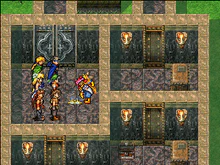Spores of Agony: Difference between revisions
From Gensopedia
More actions
No edit summary |
mNo edit summary |
||
| Line 1: | Line 1: | ||
[[File:Spores of Agony.png|thumb|right|220px|And I threw it on the ground!]]The '''Spores of Agony''' (人食い胞子, ''Hito-gui hōshi,'' Cannibalism Spores) are a dangerous biological weapon | [[File:Spores of Agony.png|thumb|right|220px|And I threw it on the ground!]]The '''Spores of Agony''' (人食い胞子, ''Hito-gui hōshi,'' Cannibalism Spores) are a dangerous biological weapon. | ||
When exposed to a human being, the spores quickly close in on their prey. A human can live for a short time as the spores devour them, remaining conscious of the loss of their senses. The Spores of Agony completely devours its victims, leaving only their clothing and personal effects behind. | The spores take a great deal of effort to cultivate and devour human flesh, taking action quickly. When exposed to a human being, the spores quickly close in on their prey. A human can live for a short time as the spores devour them, remaining conscious of the loss of their senses. The Spores of Agony completely devours its victims, leaving only their clothing and personal effects behind. | ||
During the [[Gate Rune War]], [[Gremio]] fell victim to the Spores of Agony, unleashed at [[Soniere Prison]] by [[Milich Oppenheimer]]. | During the [[Gate Rune War]], [[Gremio]] fell victim to the Spores of Agony, unleashed at [[Soniere Prison]] by [[Milich Oppenheimer]]. | ||
Revision as of 12:11, 3 November 2019

The Spores of Agony (人食い胞子, Hito-gui hōshi, Cannibalism Spores) are a dangerous biological weapon.
The spores take a great deal of effort to cultivate and devour human flesh, taking action quickly. When exposed to a human being, the spores quickly close in on their prey. A human can live for a short time as the spores devour them, remaining conscious of the loss of their senses. The Spores of Agony completely devours its victims, leaving only their clothing and personal effects behind.
During the Gate Rune War, Gremio fell victim to the Spores of Agony, unleashed at Soniere Prison by Milich Oppenheimer.
References
- Gensosuikoden Kiwami Encyclopedia, page 29
